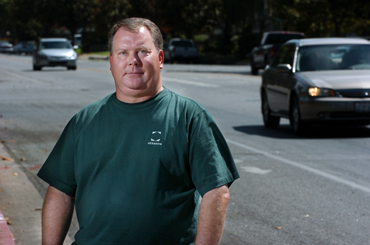
Mike Waller, a principal associate with Hexagon Transportation
Consultants, offered his opinion on the need to widen Hwy. 156 and
the challenges facing other local roadways. He has provided
professional transportation planning services to public and private
clients for more than 30 years.
Mike Waller, a principal associate with Hexagon Transportation Consultants, offered his opinion on the need to widen Hwy. 156 and the challenges facing other local roadways. He has provided professional transportation planning services to public and private clients for more than 30 years. He graduated from Oklahoma City University with a degree in Political Science and attended Graduate School at the University of Oklahoma where he studied transportation planning. He has worked in Northern California since 1987. Waller is not involved in work relating to the improvement of Hwy. 156 and emphasized that the opinions he offered are not those of Caltrans or other government agencies.
Q: Does Hwy. 156 need widening or would better-designed intersections increase traffic flow?
A: It needs to be widened to increase its capacity to accommodate the ever-increasing volume of goods and people moving between the Central Valley and the Monterey Bay Area. Population and employment are steadily increasing in both California’s Central Valley and in the Monterey Bay Area. Therefore, we all need to understand that the need for widening this highway is not exclusively due to growth associated with development in Northern San Benito County.
Q: How does the Hwy. 156 project compare to the Hwy. 25 project? Should 156 be the priority?
A: Highway’s 152 and 156 are vital transportation routes benefiting the entire state of California because they are the key routes associated with the movement of goods and people from the Central Valley to both the San Francisco and Monterey Bay Areas. Hwy. 25 primarily provides a link between San Benito County, the city of Hollister and the San Francisco Bay Area. This function is important, particularly for commuters, but not nearly as vital to our statewide interests as the connections provided by state Highways 152 and 156.
I believe everyone understands that crashes could be reduced along these highway segments if they were widened and included medians and median barriers.
Q: What are the other alternatives to widening Hwy.156 to four lanes?
A: I do not think there are any other effective alternatives. However, there are alternative ways of widening Hwy. 156.I believe Caltrans needs to focus on “buying” the best possible highway facility that can be obtained with the available funding resources. Generally this will involve maximizing highway capacity and minimizing access. Generally speaking, the county can chose to either have the highway pass through the county with a minimum of access provided to local residents and businesses or ask Caltrans to provide specific access opportunities.
For example, if the county residents such as those living in San Juan Bautista, are sincerely concerned about the potential traffic impacts to their community, they would be well advised to argue in favor of restricting access to it as it passes through their community, but not against improving the highway.
Q: What is needed for this highway to go from Grade “F” to Grade “A”?
A: Level of service on a two-lane, rural, undivided highway is evaluated based on the ability of drivers to maneuver. Because drivers cannot unilaterally choose to change lanes, pass slower vehicles or select their own travel speed on an undivided two-lane highway, the flow rate that represents a level of service “F” condition is typically very much lower than for roadways with four or more lanes. The only improvement that will significantly improve the level of service along the two-lane segment of Highway 156 is widening the highway.
Q: Some people have suggested that once the highway is widened to 4 lanes it will just prompt more people to use it and create the same problems all over again.. Is that likely?
A: California is going to continue growing. Our population is going to increase. The number of jobs in the state are going to increase. The various regions of the state are going to become increasingly commercially interdependent and these factors are going to lead towards increased travel between regions like the Central Valley and the Monterey Bay Area. The result will be higher auto and truck volumes on routes like Highway 156. This will be true regardless of whether Caltrans improves the highway. If the highway is widened fewer of us are likely to be injured or killed while using the highway. Either way the volume of traffic is going to increase.
Q: Would widening 156 create traffic problems in other areas, such as San Juan Bautista?
A: I suppose that the answer to this question depends on someone’s definition of what is a traffic problem. If Hwy. 156 were widened to accommodate increasing traffic volumes and if some of those travelers exited the highway to visit San Juan Bautista, some residents might perceive the increased traffic as a problem while local businesses might perceive a definite benefit.
Q: Would construction of the so-called “3-in-1” bypass be a better solution than widening the 156?
A: I need to emphasize that I am providing my own personal opinions and my thoughts do not necessarily reflect the views of any government agency or public official. The so-called “3-in-1” highway would, as I understand it, be an entirely new highway that would traverse open agricultural land and have the potential to encourage a significant amount of heretofore unplanned urban development in Northern San Benito County. The “3-in-1” name sounds clever, but in reality this would be a fourth major highway in Northern San Benito County. Consequently, I believe that the “3-in-1” proposal would not provide the added capacity needed along Highways 25, 152 and 156. I believe its capacity would be quickly consumed by traffic associated with new urban development.









